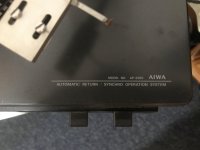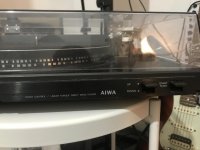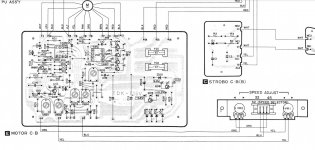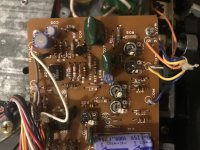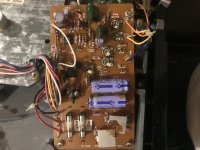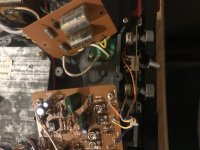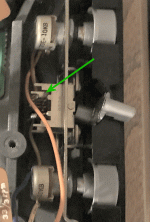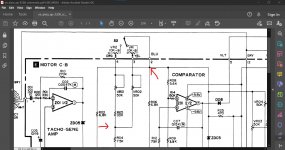My Aiwa AP-2200 turntable is stuck on 45rpm.
I was playing a 33rpm record and had paused it (pressed down the up/down switch), and when I came back to play it again the record was spinning much faster than it should be. I took the record off and placed a 45rpm one on to see whether that played properly and it did. I then toggled the switch from 33rpm to 45rpm and the speed stayed the same. It's like for some reason the 33rpm setting is playing at 45rpm. I adjusted the fine-tuning rollers on both settings and the 33rpm one still controlled that side, so the switch still does something.
Any ideas?
I was playing a 33rpm record and had paused it (pressed down the up/down switch), and when I came back to play it again the record was spinning much faster than it should be. I took the record off and placed a 45rpm one on to see whether that played properly and it did. I then toggled the switch from 33rpm to 45rpm and the speed stayed the same. It's like for some reason the 33rpm setting is playing at 45rpm. I adjusted the fine-tuning rollers on both settings and the 33rpm one still controlled that side, so the switch still does something.
Any ideas?
Last edited:
That number comes up as a stylus for me...
I'm guessing this TT uses a simple DC motor and two presets to adjust the speed (your tuning rollers?)
We are going to have to know more about the model and/or perhaps some pictures showing the switch, motor and general layout.
It sounds a simple problem and it could still be switch related but it would need some simple tests to confirm that.
I'm guessing this TT uses a simple DC motor and two presets to adjust the speed (your tuning rollers?)
We are going to have to know more about the model and/or perhaps some pictures showing the switch, motor and general layout.
It sounds a simple problem and it could still be switch related but it would need some simple tests to confirm that.
Whoops you're right, an8745 is the stylus number not the model number. The model number is AP-2200. I've attached some pictures of the turntable, and the front page of the manual. I can send more if that helps 🙂
Attachments
Last edited:
This is probably bad advice, but I would pull the thing apart and look for an obvious switch problem if I was you.
Yeah I'm reluctant to open it up until I have more of an idea of what the problem might be. If it seems like something I wouldn't be able to fix then I'd rather leave it shut until things open up again and I can take it to a professional.
The schematic is available on vinyl engine --looks straightforward but if Paddy is not conversant with electronics nor has test equipment then as he said --"I can take it to a professional "
Sometimes Deoxit on switches makes wonders. It could also be a broken or disengaged lever. Open it and look inside.
Electrically, it can only be "the switch". Or the external lever. Like the click in a ballpoint pen, sometimes it just needs un-sticking, sometimes it can't be fixed without new parts. At an extreme you could drill a hole and mount a $2 switch, run wires to the old switch terminals. But a lot of screws to get it open and possibly some parts ready to jump out.
Some turntables have grease that solidifies over time, jamming up the mechanisms, its worth careful investigation to see if this is an issue.
Cheers guys. I think I'll take a look inside when I get the opportunity to set a few hours aside for it. Then report back 

Okay so I’ve taken a look inside and as far as I can tell there are a few components that look to me to be a bit worse for wear, namely the component labelled VR02. Could this be causing the issue?
Attachments
Last edited:
With the unit un-powered, measure continuity between BLU-YEL & BLU-ORG & actuate the switch between readings. Check all cables are nor loose or broken.
Okay.... VR02. Could this be causing the issue?
Electrically, it can only be "the switch". Or the external lever. .....
Attachments
Why does the issue have to be the switch? This would make perfect sense to me if the 33rpm fine-tune wheel did not work when the switch was set to 33rpm, but it does. So does this not suggest that the switch may still be working correctly? I'm a bit of a noob when it comes to this so please forgive me if I'm missing something obvious.
If you can follow how it works then you should be able to find the problem... look at the diagram and try and follow this:
The main circuit is unchanged between 33 and 45rpm.
The resistance between the two arrowed points sets the speed.
The arrow on the right goes to the 'common' terminal of a switch.
As you move the switch the 'common' contact connects to one or other of the two other switch terminals. So that is the first thing to check. That you have zero ohms (a short) between the common and one or other of the other terminals.
The switch simply connects a 'resistor chain' between the two arrowed points. The value of the total resistance sets the speed.
With the switch connected as in the diagram you have VR02 and VR1 in series.
Don't be afraid to twiddle those two presets marked VR01 and VR02. If you suspect one then give it a good whizz to and fro and then place back approximately where it was. The speed is easily got right once its fixed.
The main circuit is unchanged between 33 and 45rpm.
The resistance between the two arrowed points sets the speed.
The arrow on the right goes to the 'common' terminal of a switch.
As you move the switch the 'common' contact connects to one or other of the two other switch terminals. So that is the first thing to check. That you have zero ohms (a short) between the common and one or other of the other terminals.
The switch simply connects a 'resistor chain' between the two arrowed points. The value of the total resistance sets the speed.
With the switch connected as in the diagram you have VR02 and VR1 in series.
Don't be afraid to twiddle those two presets marked VR01 and VR02. If you suspect one then give it a good whizz to and fro and then place back approximately where it was. The speed is easily got right once its fixed.
Attachments
^ This. Besides, VR02 does look pretty crusty, as does VR05. Might be a case for some contact cleaner, though you have to be careful as you can't use just anything (there's this stuff called Caig FaderLube F5, which the pitch pot may also appreciate, but it's a bit $$$). This style of single-turn pot should still be readily available at parts distributors.
BTW, it looks like each pot has a splash of paint on it to keep it from turning, and VR01 and VR02 have been tweaked before. Should be a good indication of position to aim for either way. Setting the speed can be a bit unnerving as you often have to set up the player on two stacks of books or similar so you can get to the pots from underneath.
BTW, it looks like each pot has a splash of paint on it to keep it from turning, and VR01 and VR02 have been tweaked before. Should be a good indication of position to aim for either way. Setting the speed can be a bit unnerving as you often have to set up the player on two stacks of books or similar so you can get to the pots from underneath.
Thanks for all your help guys! Checking the resistance with a multimeter turned out to be trickier than I thought because of the way the circuit board and wires were arranged. I ended up fixing it in a bit of a hacky way, by messing about with the variable resistors. I've now got the TT to spin at 33 when set to 45, and that works just fine for me atm.
If it works for you 🙂 that's all that matters.
You can always revisit it at some later date if you want.
You can always revisit it at some later date if you want.
This is what I did restoring my vintage Pioneer Turntable:
Rotate the front pots to center position and don't touch them any more. Mine had only one.
Place the platter and a disc playing. Weight upsets speed.
Clean and adjust trim pots one at a time, Use the switch.
After a few minutes playing in order to warm up & stabilize speed, tweak if necessary.
Enjoy a few disc tunes & confirm speed is stable.
You need an album and a Single or Maxi-single.
Rotate the front pots to center position and don't touch them any more. Mine had only one.
Place the platter and a disc playing. Weight upsets speed.
Clean and adjust trim pots one at a time, Use the switch.
After a few minutes playing in order to warm up & stabilize speed, tweak if necessary.
Enjoy a few disc tunes & confirm speed is stable.
You need an album and a Single or Maxi-single.
- Home
- Source & Line
- Analogue Source
- Aiwa an8745 turntable stuck on 45rpm
